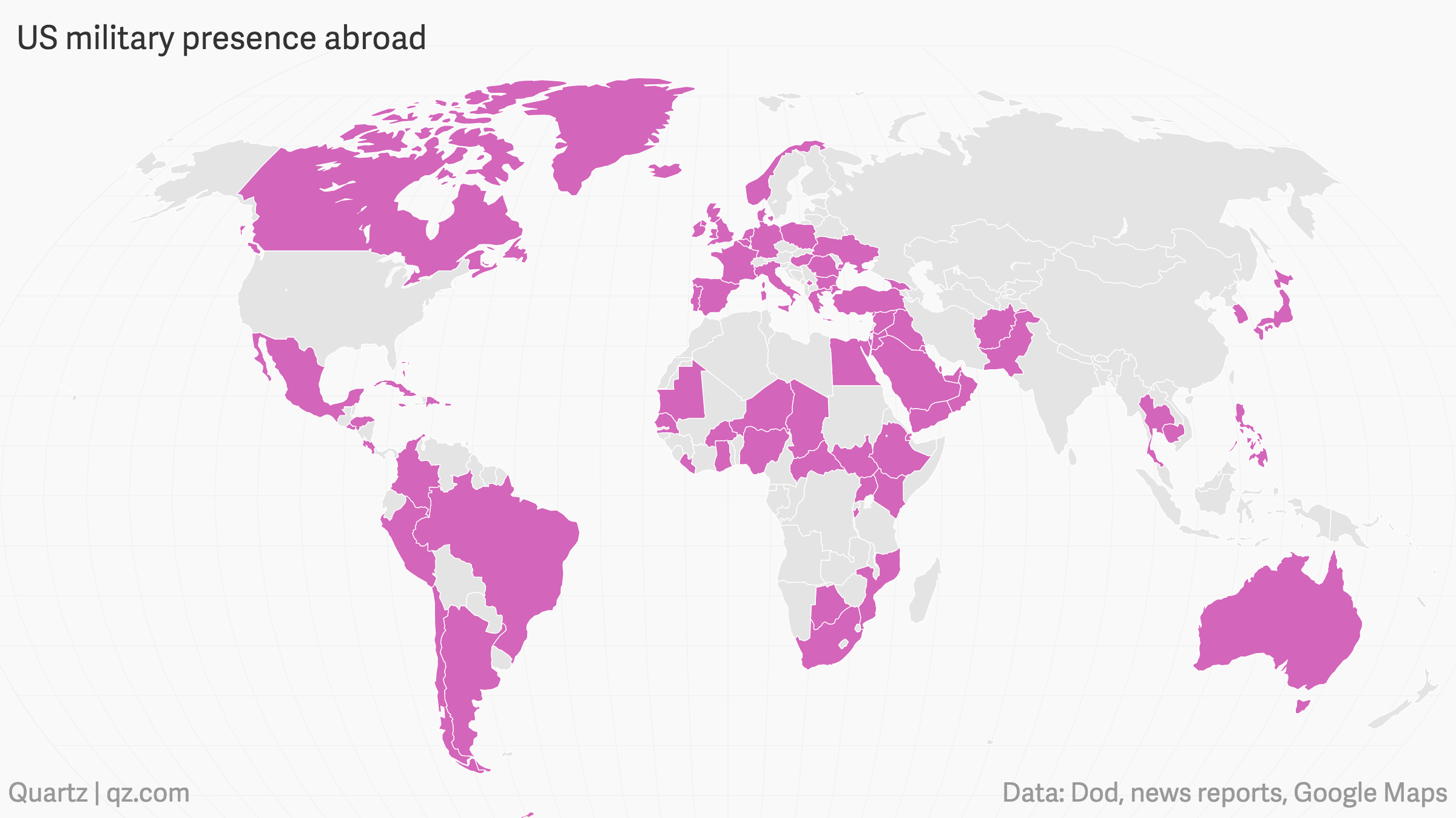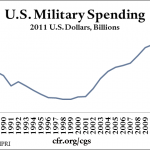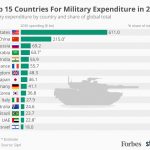The United States armed forces with approximately 1.3 million active personnel, 800,000 reserve personnel, 9000 tanks, 14000 aircraft, 10 nuclear-powered aircraft carriers, 72 submarines and 4000 nuclear warheads is undoubtedly the strongest military force on this planet. A force that is feared and/or respected across the globe. With an annual budget upwards of $600 billion, it is by far the largest military spender in the world. The margin is so huge that the United States alone overshadows the next top 7 spenders, spending thrice as much as China and overshooting its cold war nemesis by a factor of 10. While the American economy has shrunk from 32 to 22 percent in terms of contribution to global GDP in the 21st century, its defence spending has doubled during the same interval of time. Home to mere 4.3% of the world population and 6.14% (at 9.14 million Km^2 of 148.94 million Km^2) of the world’s total land mass the United States accounts for 36% of its Military Expenditure.
But the spending spree of the United States armed forces does not end here. The general military budget, a whopping $600 billion, does include the $20 billion a year spent by the US for the upkeep of its nuclear arsenal (the United States Department of Energy is responsible for all the nuclear weapons). Nor are the expenses from the country’s wars in Afghanistan and Iraq accounted for in the general defence budget, being funded through separate spending bills. Apart from these, a number of other programs, such as pensions for military veterans, intelligence activities, homeland security, and counter-terrorism activities are also not included in the military budget amounting anywhere between $218 billion to $262 billion. If these expenses were to be combined with the normal military budget, then the total U.S defence spending would very well cross the TRILLION dollar mark. All these stats and facts will make any rational human ask the now TRILLION dollar question, where does all this money go? and does the United States actually need to spend so much?

Now the generic answer to the above questions would be that the US has a huge military which is very advanced and maintains a global presence hence the expense and the answer to the other part would be YES. With people trying to justify all of it by saying that a super power needs to have a huge military… everybody is spending more behind its military… and that the US “only” spends 3.5% of its enormous $18 trillion GDP, while Russia spends 4.5% and Saudi a colossal 10.4% of its GDP. But if you probe your way into these questions you find a much different answer. As said by the then-Secretary of Defense Robert Gates in May 2011, he described the Pentagon’s business operations as “an amalgam of fiefdoms without centralised mechanisms to allocate resources, track expenditures and measure results. … My staff and I learned that it was nearly impossible to get accurate information and answers to questions such as ‘How much money did you spend’ and ‘How many people do you have?’ “. Coming to whether the US needs to spend as much,? Analysts believe that the 92% rise in the U.S. military budget by 2008 (As compared to its 1998 budget) led to a 65% rise in global military spending by 2011 for when the U.S. cut its military budget by a third between 1985 and 1998, the rest of the world followed suit and global military budgets also fell by a third between 1988 and 1998.

After the fall of the Soviet Union and the end of the cold war instead of reaping benefits from the “Peace Dividend” the US went after the “Power Dividend”, increasing its military expenditure and investing on weapons in order to increase its global influence and dominance. But what started off as a quest for global dominance in no time spiralled into an uncontrolled spending frenzy, with the armed forces investing in frilly technologies and buying up equipment it does not need or have the money for. Be it the navy’s Zumwalt class destroyers ( the cost $3.2 billion a piece + $10 billion spent on R&D) or its Long Range Land Attack Projectile ( $1-0.8 million a piece) or the Litoral Combat Ships the air forces F-35 program or the armies Future Combat Systems (a cancelled project with an estimated sunk cost of $ 18.1 billion) or the RAH-66 ( another failed project with a sunk cost of about $7 billion) all of them prime examples of wasteful spending on superfluous technologies. However, this splurge is not limited superfluous technologies, the armed force also keeps buying parts and equipment it does not even need. Take for example the M1-Abrams tanks, the army has approximately 10,000 of these tanks with an average fleet age of just 2.5 years, mainly because almost half of these tanks are in storage. Yet the army keeps buying new ones ever year, allocation millions of dollars for their procurement. You want more? Take a look at the Defense Logistics Agency (DLA), which buys, stores and ships much of the Defense Department’s supplies they always have way more than they need. It’s not me who is saying it but Navy Vice Admiral Mark Harnitchek and the director of the DLA who said “We have about $14 billion of inventory for lots of reasons, and probably half of that is excess to what we need” on August 7, 2013, while meeting with aviation industry executives. Yet, as of a September 2012 document by Pentagon, the DLA and the military services had $733 million worth of supplies and equipment on order that was already stocked in excess amounts (excess amount/inventory = anything more than a three-year supply) on warehouse shelves. Just to keep the giant wheels of the American war machine turning and pretending to save American jobs when in fact all this money could be spent generating new more sustainable and constructive ones.

We have not even started on how the Pentagon doctor’s its ledgers to conceal epic waste or why the Pentagon reported $9.2 billion in “reconciling amounts” in 2012 to make its numbers match with that of the treasury’s. Though the Pentagon might not necessarily be cheating, stealing or lying, their booking skills are so erroneous that a single DFAS office in Columbus, Ohio, made at least $1.59 trillion – yes, trillion – in errors, including $538 billion in plugs, in financial reports for the Air Force in 2009, according to a December 2011 Pentagon inspector general report. Amounts which far exceeded the Air Force’s total budget for that year. While, the Pentagon has spent tens of billions of dollars to upgrade to new, more efficient technology in order to become audit-ready. Many of these new systems have failed miserably, either unable to perform all the jobs they were meant to do or scrapped altogether – only adding to the waste they were meant to stop. Neither to we intend to discuss $70 billion worth of in stock with the DLA and why it destroyed ammunitions worth $1.2 billion in 2014. Nor will we be asking why 16 cargo planes for the Afgan Air Force worth almost 1/2 a billion were sold as scrap metal for $32,000. But I would like to ask is, Why is the United Staes buying weapons that have less to do with battlefield realities than their unending faith that advanced technology will ensure victory, and with the economic interests and political influence of contractors? Let alone the Vietnam war, have they not learned anything from the crushing defeat in the Millennium Challenge of 2002, when one aircraft carrier, ten cruisers and five of six amphibious ships of the Blue Force (US force) were sunk on the very first day by a technologically and numerically inferior Red Force. Why are the taxpayers and soldiers of the United States of America paying in cash and kind for wars that adversely affect their own nation? Has the average American grown so accustomed to the idea of war, that they can not see the death and destruction it brings? Or have the politicians and contractors succeeded into making America believe that war is what makes it great?

I have no idea as for who or what the enemy is that the United States is trying to protect itself from. All I know is that a trillion+ dollars is a lot of money to put into an infernal war machine instead of building a permanent structure of peace especially at a time when the nation is under $19 trillion debt. Yet some Americans still demand an increase in military expenditure without understanding that spending smart is the need of the hour not spending a lot. For its the extravagance that is a cause for concern, not moderation. Else America could be substantially exposed if it ever comes face to face with a true adversary.






My simple understanding of this problem is as follows: The weapons and defence merchandise industry in the US has become a hungry lion that needs to be fed with taxpayers dollars or it will eat Mr. President for breakfast.
Nice work, jetboy!
Excellent post. I was checking continuously this weblog and I am inspired!
Extremely helpful information specially the closing phase 🙂 I care for such info a
lot. I used to be looking for this particular information for a long
time. Thank you and best of luck.
Thanks a lot for the appreciation.
At a time when the United States is fighting a war, fly-bys provide feel-good moments for fans, for sports leagues and even for athletes themselves – a spectacle that gives any sporting event added prestige and excitement.
plastic shower heads are cheaper and you can easily install them, they are not as durable as brass showers heads but good enough**
so much great info on here, : D.
I was just looking for this info for some time. After six hours of continuous Googleing, finally I got it in your website. I wonder what’s the Google’s issue that does not rank this type of informative web sites closer to the top. Usually the top websites are full of garbage.
If you happen to could email me some ideas about how well you made your websites appear to be this , I’d be appreciative!